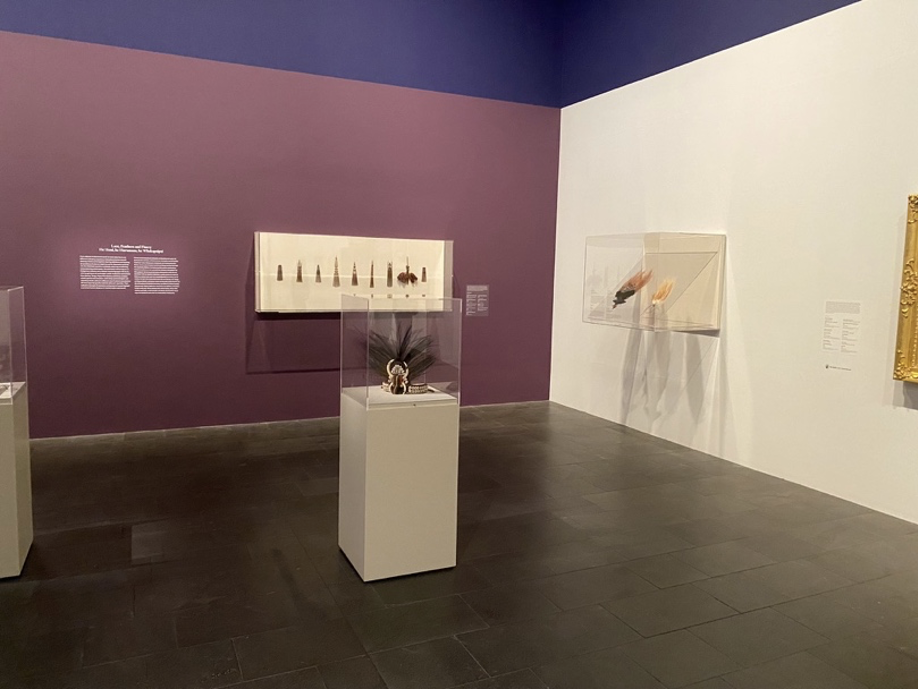Advocating: An interview with Hatesa Seumanutafa
Hatesa Seumanutafa is Curator Māori, Pacific, and Indigenous Human Histories at Canterbury Museum and a graduate of UC Anthropology. Her exhibition Ship Nails and Tail Feathers, curated alongside Peter Vangioni, Ken Hall, and Felicity Milburn, is a collaboration between the Museum and Christchurch Art Gallery Te Puna o Waiwhetū.
Hatesa Seumanutafa at work.
Q: How did you get started at UC and what was your experience like?
HS: “I did have an experience, when I was about fifteen – of visiting the Museum, and I figured that that’s where I would really like to end up. I didn’t know how, and I didn’t think I could get there through academia – I was actually really thinking of going and working in the museum in the café.”
“I actually contacted Roger Fyfe [Emeritus Curator of Human History] from the Museum to see if we could meet, and if he could help me navigate what it is I needed to achieve at Canterbury University to ensure that my pathway would lead to the Museum.”
“When I started, I didn’t actually do too well in that first year, and… I stopped. And I then got my shit together and came back, all guns blazing.”
“I was very much trying to do my art, and I was tutoring stone sculpture, I was just very much working. And that was kinda taking priority. And so, it wasn’t until I got my personal life in order that I could actually begin university. And that was a good move for me.”
“My background is very practical – I thought that coming into uni would kind of balance that out in terms of working in the Museum.”
Ship Nails and Tail Feathers, August 8, 2023.
Q: Were you drawn to Anthropology from the start?
HS: “It’s a subject that Roger had proposed and really encouraged me to get into. My main subject was Anthropology, but I did take those crossover papers – and one of the crossover papers was Exploring the Past, that was with Lyndon [Fraser], and that was fantastic.”
“How practical it was, and applicable. And it didn’t really ask me to regurgitate a lot. It actually had me thinking, myself, about things. And having those types of assessments where your voice is heard – I thought was really impactful in terms of how you locate yourself as a researcher or an academic.”
“It was a lot of reflecting – instead of just that, kinda, ‘reading readings.’ I mean, that’s probably a good thing to learn, to read what there is and what has been the foundations of theories… but to know how to apply it is one of the best skills, I think, that you can come out of university having.”
Q: How would you describe your work as a Curator?
HS: “I’m only newly a curator – I started off in the museum as a Collections Technician. So, me being a curator now is an accumulation of ten years at the museum. And then prior to that, experiences researching within the museum, and having an internship at Canterbury Museum.”
“Years and years of being a Collections Technician allowed me to know the collection on a first-hand, face to face level. And then as an Associate Curator, it was learning how to assist curators and kind of take on some of their tasks. Being a Curator now, it’s just an accumulation of everything I've ever done. And having observed at all these different levels: what's needed, and what would work better, and what doesn't work, and all of that.”
Ship Nails and Tail Feathers, August 7, 2023.
Q: Do you have a specific curatorship style?
“I don't think I have a style of curating; I just think that there's just a way of going about things that help. How we can curate, how we curate when we're on our own, how we curate when we're collaborating, how we curate when we're dealing with a difficult subject… pretty much right throughout anything I do, I'm either directly or indirectly advocating. And directly or indirectly, I am trying to push for our histories within the Pacific to be seen – that's including Māori histories and Pacific histories.”
“I feel like my role within the Museum is not just for the public, it’s for – internally, mainly. My core belief is, and has always been, to work from the inside out.”
Ship Nails and Tail Feathers runs at the Christchurch Art Gallery until October 22nd.



